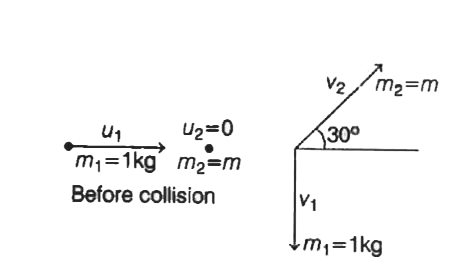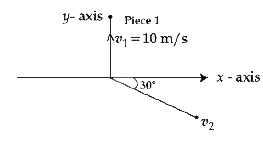A ball of mass 1 kg moving along x-direction collides elastically with a stationary ball of mass m. The first ball (mass = 1 kg) recoils at right angle to its original direction of motion. If the second ball starts moving at an angle 30∘ with the X-axis, then the value of m must beSolution in Telugu
0.5 kg
1.5 kg
2.5 kg
2 kg
The correct Answer is:D

According to the law of conservation of momentum,
1×u1=mv2cos30∘ (X-axis)
⇒ u1=√32mv2
and 1×v1=mv2sin30∘ (Y-axis)
v1=12mv2
From kinetic energy conservation,
12u21=12v21+12mv22
⇒ u21−v21=12mv22
On putting the values of u1 and v1, we get
34m2v22−14m2v22=12mv22
⇒ m=2kg
Topper's Solved these Questions
Similar Questions
A force F is applied in a square plate of length L . If the percentage error in the determination of L is 3% and in F in 4% then permissible error in the calculation of pressure is
View SolutionA tokamak fusion test reactor works on
View SolutionA ball of mass 1kg moving with 4m^-1 along +x-axis collides elastically with an another ball of mass 2kg moving with 6m//s is opposite direction. Find their velocities after collision.
View SolutionA ball 'A' of mass 'm' moving along positive x-direction with kinetic energy K and linear momentum "p" undergoes elastic head on collision with a stationary ball 'B' of mass M . After the collision, the ball A moves along negative x-direction with kinetic energy K//9 , the final linear momentum of the ball B is
View SolutionA ball A of mass 1 kg , moving with a speed of 12 m//s , collides obliquely and elasticity with another ball B which was initially at rest. Ball A then moves off at the right angle to its initial direction with a speed of 5 m//s . The momentum of ball B after the collision is
View SolutionA ball of mass M collides elastically with another stationary ball of mass m. If M>m, find the maximum angle of deflection of M.
View SolutionA ball of mass m moving with a velocity v undergoes an oblique elastic collision with another ball of the same mass m but at rest. After the collision if the two balls move with the same speeds , the angle between their directions of motion will be:
View SolutionA ball of mass 1 kg moving with a velocity of "0.4 ms"^(-1) collides with another stationary ball. After the collision, the first ball moves with a velocity of 0.3ms^(1) in a direction making an angle of 90^(@) with its initial direction. The momentum of the second ball after the collision will be (in kg ms^(-1) )
View SolutionA ball of mass 1 kg moving along x-direction collides elastically with a stationary ball of mass m. The first ball (mass = 1 kg) recoils at right angle to its original direction of motion. If the second ball starts moving at an angle 30∘ with the X-axis, then the value of m must be
View SolutionA ball of mass 4 kg moving on a smooth horizontal surface makes an elastic collision with another ball of mass m at rest in the line of motion of first ball. If after collision first ball moves in the same direction with one fourth of its velocity before collision, then mass of second ball is
View SolutionA ball of mass m_(1) moving with a certain speed collides elastically with another ball of mass m_(2) kept at rest . If the first ball starts moving in reversed direction after the impact then
View SolutionA ball .A. of mass .m. moving along positive x-direction with kinetic energy .K. and momentum P undergoes elastic head on collision with a stationary ball B of mass .M. . After collision the ball A moves along negative X-direction with kinetic energy K9 Final momentum of B is
View SolutionA ball of mass 10 kg moving with a velocity 10√3m/s along the x-axis, hits another ball of mass 20 kg which is at rest. After the collision, first ball comes to rest while the second ball disintegrates into two equal pieces. One piece starts moving along y-axis with a speed of 10 m/s. The second piece starts moving at an angle of 30 with respect to the x-axis. The velocity of the ball moving at 30∘ with X-axis is x m/s. The configuration of pieces after collision is shown in the figure below.
The value of x to the nearest integer is ______

View SolutionA ball of mass 1kg moving with 4m^-1 along +x-axis collides elastically with an another ball of mass 2kg moving with 6m//s is opposite direction. Find their velocities after collision.
View Solutionएक .m. द्रव्यमान की गेंद नियत वेग से गति करती हुई। एक अन्य स्थिर गेंद से प्रत्यास्था टक्कर करती है। अगर आपतित गेंद की अधिकतम गतिज ऊर्जा की हानि होती है तो स्थिर गेंद का द्रव्यमान होगा।
View Solution
